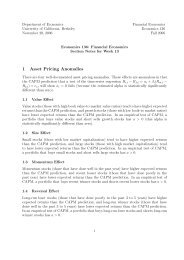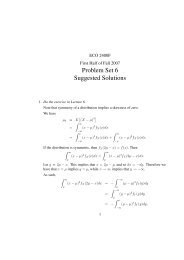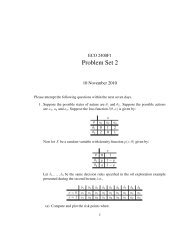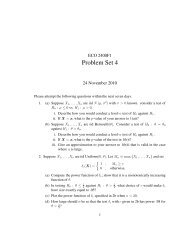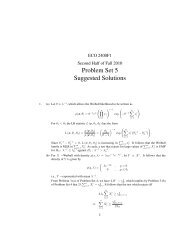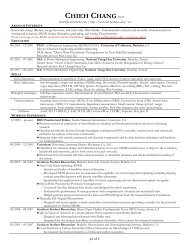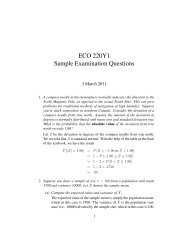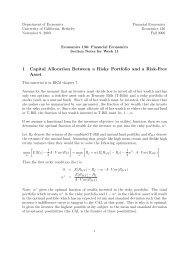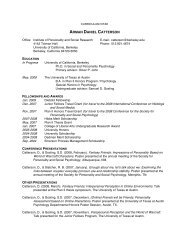A Context for Bela Bartok on the Eve of World War II: The Violin ...
A Context for Bela Bartok on the Eve of World War II: The Violin ...
A Context for Bela Bartok on the Eve of World War II: The Violin ...
Create successful ePaper yourself
Turn your PDF publications into a flip-book with our unique Google optimized e-Paper software.
epercussi<strong>on</strong>s Spring-Fall 1996<br />
In fact, <strong>on</strong>ce <strong>on</strong>e is alert to <strong>the</strong> presence <strong>of</strong> verbunkos elements<br />
in <strong>the</strong> first movement <strong>of</strong> <strong>the</strong> <strong>Violin</strong> C<strong>on</strong>certo, <strong>on</strong>e<br />
hardly knows where nineteenth-century verbunkos leaves<br />
<strong>of</strong>f and o<strong>the</strong>r related elements-Hungarian peasant s<strong>on</strong>g,<br />
<str<strong>on</strong>g>for</str<strong>on</strong>g> example-begin. More specifically, as I have already<br />
hinted by my adjectival use <strong>of</strong> "Gypsy," <strong>the</strong> questi<strong>on</strong> arises:<br />
Which <strong>of</strong> <strong>the</strong>se so-called verbunkos gestures are derived<br />
from /I au<strong>the</strong>ntic" peasant culture-to return to Bart6k's<br />
earlier writings-and which from what he had c<strong>on</strong>sidered<br />
<strong>the</strong> /I corrupt" imitati<strong>on</strong>s <strong>of</strong> urban Gypsy bands or<br />
nineteenth-century Hungarian composers? Indeed, we are<br />
<str<strong>on</strong>g>for</str<strong>on</strong>g>ced to ask a questi<strong>on</strong> fundamental to Hungarian music, a<br />
questi<strong>on</strong> never broached satisfactorily in Bart6k' s own writings<br />
and subsequently ill-defined in every history <strong>of</strong><br />
Hungarian music or dicti<strong>on</strong>ary <strong>of</strong> musical terms known to<br />
me:55 What is this thing called verbunkos-is it Gypsy<br />
music, a Transylvanian peasant violin style, an ensemble, a<br />
recruiting dance, a <str<strong>on</strong>g>for</str<strong>on</strong>g>m, an accompaniment, a melody, or<br />
55. In additi<strong>on</strong> to Bart6k's writings, works I have c<strong>on</strong>sulted include:<br />
Marian Prikkel Re<strong>the</strong>i,A magyarsag tancai (Hungarian dances) (Budapest,<br />
1924); Zenei lexik<strong>on</strong>, ed. Bence Szabolcsi and Aladar T6th (Budapest, 1930);<br />
Gyorgy Martin, Magyar ttinctipusok es tancdialektusok (Hungarian dance<br />
types and dance dialects) (Budapest, 1970); Bence Szabolcsi, A C<strong>on</strong>cise<br />
History <strong>of</strong> Hungarian Music, trans. Sara Karig and Fred Macnicol<br />
(Budapest, 1974); Gyorgy Martin, Hungarian Folk Dances (Budapest, 1974);<br />
entries <strong>on</strong> "Verbunkos," "Gypsy Music," and "Hungary," in <strong>The</strong> New<br />
Grove Dicti<strong>on</strong>ary <strong>of</strong> Music and Musicians, ed. Stanley Sadie (L<strong>on</strong>d<strong>on</strong>, 1980);<br />
ZoItan Kodaly, A magyar nepzene (Hungarian folk music) ed. Lajos<br />
Vargyas (Budapest, 1981); Gyorgy Martin and Andras Takacs,Matyusf61di<br />
nepi tancok (Folk dances <strong>of</strong> Matyusfold) (Bratislava, 1981); Riemann zenei<br />
lexik<strong>on</strong>, ed. Carl Dahlhaus, Hans Eggebrecht, and Antal Bor<strong>on</strong>kay<br />
(Budapest, 1983); Geza Papp, "Die Quellen der 'Verbunkos-Musik': Ein<br />
bibliographischer Versuch," Studia musicologica (1979): 152-217; (1982): 35-<br />
97; (1984): 59-132; (1990): 55-224; "Hungarian Dances (1784-1810)," Musicalia<br />
Danubiana vol. 7, ed. Geza Papp (Budapest, 1986); Balint Sarosi, Folk<br />
Music: Hungarian Musical Idiom, trans. Maria Steiner (Budapest, 1986);<br />
Katalin Paksa, Magyar nepzenekutatas a tizenkilencedik szazadban (Hungarian<br />
folk-music research in <strong>the</strong> nineteenth century) (Budapest, 1988); Ferenc<br />
Sebo, Nepzenei 01vas6k6nyv (A folk-music reader) (Budapest, 1990); Ferenc<br />
B6nis, "Bart6k es a verbunkos" (Bart6k and verbunkos),H6dolat Bart6knak<br />
es Kodalynak (Budapest, 1992), 19-31. I thank Agnes Papp <str<strong>on</strong>g>for</str<strong>on</strong>g> her help in<br />
procuring a number <strong>of</strong> <strong>the</strong>se Hungarian publicati<strong>on</strong>s.<br />
57



